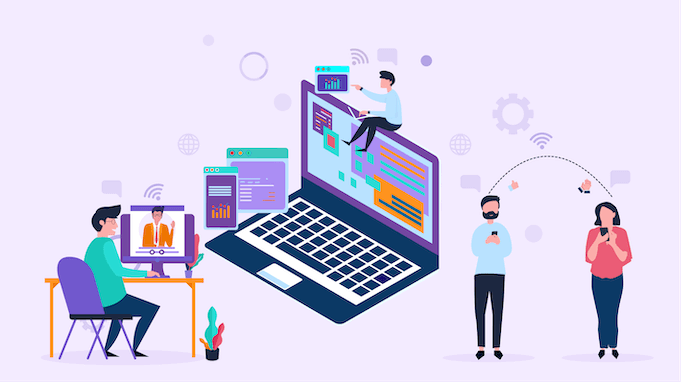Technology In The Workplace: Benefits, Concerns, Tips To Implement
From the clattering keywords of a typewriter to getting real-time updates with a press on the keyboard, the work culture has come a long way. And the adoption of technology in the workplace has massively impacted how we used to work.
Initially reliant on manual typewriters, we now harness computers, the internet, and mobile devices to streamline tasks and communicate globally. But the advent of hybrid work models, where remote and in-person work seamlessly co-exist, has been a defining aspect of this evolution. The introduction of tools like ChatGPT, powered by AI, has become integral of late. Augmenting our ability to gather insights, answer queries, and collaborate effectively.
Yet, this transformation also prompts us to navigate ethical and societal impacts. It highlights the importance of using technology responsibly that supports and enhances human abilities rather than replacing them.
Key Takeaways
- Some Advantages of Befriending Technology in the Workplace
- Challenges Posed by Technology
- Know the Workplace Functions Influenced by Technology
- Key Tips for Successfully Integrating Technology
Induction of Technology in the Workplace
The influx of technology in the workplace began with wheels and sails, facilitating humans to reach faraway lands and across the blue barrens.
Today the roots of technology have penetrated much deeper into our work lives.
Modern workplaces are now mostly occupied by tech-savvy millennials and Gen Z employees. For keeping up with their needs the inclusion of technology becomes even more important. And as such, computation has become an inseparable part of today’s workspaces.
The constant flow of innovative technology has influenced much of the workflow around today’s enterprises. Businesses are now relying more on technology than ever before to thrive in today's competitive marketplace. And this, in turn, has led to a shift in the prevailing human work nature.
Moreover, with the inception of cloud-based tools and technology, one’s workplace is no longer static. Professionals can now participate in workplace activities from anywhere they want via the internet. And this arrangement facilitated the rise of "The Remote Workers" and "Telecommuters."
At the bottom line, the use of technical tools has influenced human resources around organizations. The induction of technology has not only enabled industries to keep up with the fast-paced work culture. But it has also enabled employers to address some of the key workplace issues.
Benefits of Technology in the Workplace
1. Increased Efficiency
Technology has revolutionized the workplace by automating various tasks and processes. Computers and software applications allow for swift and accurate data processing. Further, reducing the time and effort required for manual work.
2. Collaboration and Communication
Tools like Slack, Zoom, and Microsoft Teams have transformed how teams work together. These platforms facilitate instant communication and collaboration, regardless of geographical boundaries.
Colleagues can share information, exchange ideas, and hold virtual meetings in real-time, promoting seamless teamwork and knowledge sharing.
3. Remote Work
The advent of technology has enabled employees to work from virtually anywhere. Remote work has become increasingly prevalent. Offering employees greater flexibility and a better work-life balance. This flexibility not only boosts morale but also allows organizations to tap into a broader talent pool, as they are not restricted by location when hiring.
4. Data Management and Analysis
In the digital age, businesses generate and collect massive amounts of data. Technology plays a pivotal role in efficiently managing, storing, and analyzing data. Advanced software and tools provide the capability to derive valuable insights, make data-driven decisions, and anticipate trends.
This data-driven approach helps organizations optimize operations, tailor their strategies, and stay competitive in rapidly changing markets.
5. Enhanced Workforce
Enhancements come after the right decisions are taken and applied based on accurate scalable metrics obtained.
Incorporating technology at the workplace help the employees do more with fewer efforts. This saves both their time and energy, which they can vest upon some other work. Also, the cloud-based tools enable the employees to stay at their work even when they are away. All these factors help employers keep a check on the productivity of the workforce.
Therefore, enabling them to take proper decisions to ensure an enhanced workforce.
The Challenges Posed by Technology
1. Security Concerns
In our data-driven world, technology plays a pivotal role in managing and analyzing vast collections of data. However, this technological advancement also presents a challenge of cyberattacks. These attacks are carried out with an intention to steal or disrupt data. And such attacks could have far-reaching consequences.
Cybersecurity stands as the primary line of defense against these threats. It acts as a shield, safeguarding sensitive data and critical infrastructure from potential harm. In fact, it has the potential to prevent disruptions that can lead to financial losses and reputational damage.
Hence, it is safe to say that the role of cybersecurity in the digital age is nothing short of indispensable. By using cybersecurity software, we gain the ability to protect, preserve, and secure our increasingly technology-dependent way of life.
2. Training and Adaptability
Businesses excel by harnessing data, utilizing technology to efficiently handle and scrutinize it for valuable insights. But amidst this, there’s the challenge of continuous training and adaptability. This means always learning new skills. In a world where technology evolves at breakneck speed, it’s not just an option; it’s a necessity.
3. Dependence on Technology
Imagine relying solely on your smartphone for navigation. And its battery dies in an unfamiliar place. You’d find yourself lost without any backup plan.
Over-reliance on technology means leaning on a few particular tools too much. This can become a problem because if that tool fails or isn’t accessible, it can make everyday tasks more challenging. Moreover, depending heavily on technology can lead to tech burnout. This is when you feel exhausted or stressed because you’re spending excessive time on screens.
So, it is wise to strike a balance and maintain essential skills and strategies for tasks without it.
4. Ethical Considerations
Technology raises crucial ethical concerns. First, there’s the issue of surveillance, where our online activities are constantly observed, often without our awareness. This can feel invasive and challenge our right to privacy.
Secondly, data privacy is a growing concern, as personal information is collected and used without consent. This comprises our control over our own data and raises questions about who has access to it and for what purposes.
Finally, we encounter AI biases, which occur when technology treats individuals unfairly due to factors like race or gender. Such biases undermine fairness and equality, prompting ethical dilemmas about how AI systems are designed and used in society. These ethical considerations highlight the need for responsible and thoughtful technological development.
Some of The Workplace Functions Influenced by Technology
1. Recruitment
Recruiting the best people for a job can be a tough task. And it's not likely that the employers will find the right talent just next door. However, cloud-based tools and social media have duly answered this issue. Employers can now look for and engage the right person for the job from across the horizon. The advent of social media has also played a major role in this regard.
This has not only helped organizations to diversify their workforce but also expand their presence globally.
Related: Best Recruitment Tools- A Comparison with What, Which, & Why
2. Onboarding
Onboarding is the process of making the new hires familiar with their work. As such, it requires a lot of engagement from both the employers' and employees’ ends. In large corporations, it may not always be possible to put equal emphasis on every new employee.
However, the use of proper tools in the workplace streamlines this entire process. Conducting onboarding sessions online is much easier than reaching out to every employee personally. This helps to save crucial time and resources, positively impacting the overall productivity and standard of the workplace.
3. Engagement
Employee engagement has become a necessity for every modern day enterprise. The influence of various SaaS systems similar to Vantage Circle’s employee engagement platform suite is very notable in this regard.
Employers can now engage their employees on the go irrespective of any geographical barriers that may exist.
With most working-class members belonging to the tech-savvy generation, engaging them through mobile has become the only solution. Also, adopting a cloud-based platform is now helping employers save much of their tangible resources.
4. Performance Management
This is one of the primary areas where the benefits of technology are clearly visible. Gauging workplace productivity has never been much easier before the inclusion of technology. Various performance management tools is facilitating employers to get accurate data about their workplace activities.
Based on this information, decision-makers are now able to take the right step at the correct time.
5. Workplace Surveys
Employee surveys are an integral part of modern workplaces. They provide much indeed insights into any concerned matter and helps shape decisions. The process of surveying and compiling data may become cumbersome in the case of a large workforce. However, using automated survey tools makes this task much effortless.
It makes collecting data and compiling meaningful information much faster than the conventional ways involving pen and paper.
Run Effective Workplace Surveys and Drive Engagement With Vantage Pulse
6. Employee Benefits
Delivering employee benefits is a crucial part of an organizations' employee engagement practices.These benefit may include things like employee discounts, wellness program, or rewards. These can now be easily disbursed with the help of a cloud-based platform similar to ones' provided by Vantage Circle. Involving such a platform lets the employees choose their benefits as per their desire. Thus, paving the way towards a successful employee benefits program.
7. Project Management
Project Management is another core area involving the maximum use of technology. The inclusion of such tools in the workplace simplifies the approach of managing wide array of projects at a single time. Project management software help teams to keep a close check on their day to day progress.
A project management tool also facilitates collaboration between teams.Thus, maximizing productivity and lessening efforts.
Tips For Successfully Integrating Technology
Selecting the appropriate technology tools is the cornerstone of a successful integration process. To make informed choices, consider these essential practices:
A. Best Practices for Choosing the Right Tech Tool
1. Need Assessment
Evaluate the organization’s specific technological requirements. Before diving into tech options, understand what your organization truly needs. You have to identify the challenges, and goals that technology can address. By aligning technology choices with these needs, you ensure that your investments are purposeful and effective.
2. Research
Leverage the wealth of information available online. Investigate reviews, case studies, and user testimonials of the technology tools you’re considering. This research offers valuable insights into real-world performance, potential issues, and user satisfaction, helping you make well-informed decisions.
Dive deep into user experiences and feedback to uncover the real-world pros and cons of your chosen tech tools.
3. Compatibility
Compatibility is crucial. Your chosen tool should seamlessly integrate with your current systems and workflows. This ensures a smoother transition and minimizes disruptions in your day-to-day operations.
4. Scalability
Incorporating technology into your organization’s toolkit is a forward-thinking investment. It’s imperative to opt for tools with scalability.
Think of scalability as the foundation of future-proofing. It ensures that the technology you invest in today remains viable and effective tomorrow, regardless of how your organization evolves. By choosing scalable tools, you’re fortifying your ability to adapt and thrive in the ever-changing digital landscape.
Invest in tech that grows with you, securing your adaptability and success in the evolving digital landscape.
5. Cost-Benefit Analysis
It’s essential to consider both the benefits and costs associated with a tech tool. Calculate the return on investment (ROI) by weighing the potential advantages, such as increased efficiency or revenue. This analysis helps you make financially sound decisions. And ensures that your tech choices align with your organization’s budget and goals.
By following these best practices, you lay a solid foundation for selecting technology tools. Selecting tech tools prudently not only meets your current needs but also contributes to your organization’s long-term success.
B. Employee Training and Feedback
Ensuring that your employees are well-equipped to embrace new technology is fundamental to a successful integration process. Your employees will be well-equipped only when they’re provided with effective training and feedback.
1. Regular Training
You must establish a continuous training schedule whenever new technology tools are introduced. Such an approach guarantees that all employees consistently have opportunities to learn and adapt to the changes.
2. Hands-on Workshops
Learning by doing is highly effective. Arrange hands-on workshops that enable employees to actively engage with the new technology in real-life situations. Such practical experience reinforces their understanding and boosts confidence in using the tool.
3. Feedback Channels
You must create open avenues for employees to express their thoughts and experiences with the new technology. Whether through surveys, suggestion boxes, or regular meetings. Providing feedback channels allow you to gain valuable insights into their challenges and suggestions.
Create open avenues for input, using surveys and regular meetings to uncover valuable insights.
4. Iterative Improvement
Feedback isn’t just about collecting input. It’s about using it to enhance the integration process. You have to be proactive in addressing issues raised by employees.
Turn feedback into action, proactively addressing employee concerns to refine the integration process.
5. Support System
Recognize that some employees may encounter difficulties during the transition. It is your responsibility to establish a robust support system. The support system should comprise easily accessible resources and a dedicated helpline. Such a proactive approach ensures that employees can readily seek assistance as required. Further, it helps in effectively mitigating frustration and minimizing disruptions in workflow.
Build a robust support network with accessible resources and a dedicated helpline to assist employees, minimizing workflow disruptions during transitions.
C. Staying Updated with Tech Trends
Remaining abreast of evolving technology trends is pivotal for sustainable growth. Here’s how to ensure your organization stays on the cutting edge:
1. Continuous Learning
Continuous learning is the minimum requirement for success in any field.
~Brian Tracy
Aim at fostering a culture of perpetual learning within your organization. You must encourage your employees to participate in webinars, workshops, and courses related to emerging technologies.
The ongoing education will keep their skills sharp and ensure they’re well-versed in the latest advancements.
2. Industry News
It would be important for you and your employees to stay well-informed by subscribing to industry-specific tech news platforms or magazines. Regular updates on industry trends, breakthroughs, and innovations will help your organization make informed decisions. At the same time, your employees will adapt swiftly to changes.
Stay well-informed by subscribing to industry-specific tech news platforms, enabling informed decision-making and rapid adaptation.
3. Networking
Your network is your networth.
~Poter Gale
Engaging with industry peers, both within and outside your organization to exchange insight and experiences. You must engage in collaborative discussions. As it will provide you with fresh perspectives and offer a broader understanding of emerging technologies.
4. Internal Reviews
You must establish a systematic practice of periodically reviewing and upgrading your organization’s technology stack. This involves assessing your existing tools for alignment with emerging trends. At the same time, proactively approaching opportunities to incorporate new technologies.
You must regularly conduct internal technology stack evaluations to keep your organization agile and responsive to tech shifts. Your proactive stance will ensure your continued relevance and adaptability in the dynamic digital world.
By following these tips, organizations can navigate the complex landscape of technology seamlessly. They can choose the right tools that align with their needs, and empower their employees with continuous learning.
Regularly assess your organization's technology stack for alignment with emerging trends and proactively incorporate new technologies to remain agile and responsive.
Signing off
In today's highly competitive market, technology has massively changed work culture. Enterprises around the globe are thriving for the top position with the inclusion of the latest technology in their workplace.
Issues faced by business owners earlier are no longer a concern with technology solving most of them. Involving tech at work has optimized the workflow for delivering better results in less time. And with businesses moving towards the use of cloud technology, the roles involving various tech-driven tools and services have also expanded.

















